土壤微生物研究方法
- 格式:pdf
- 大小:123.02 KB
- 文档页数:6
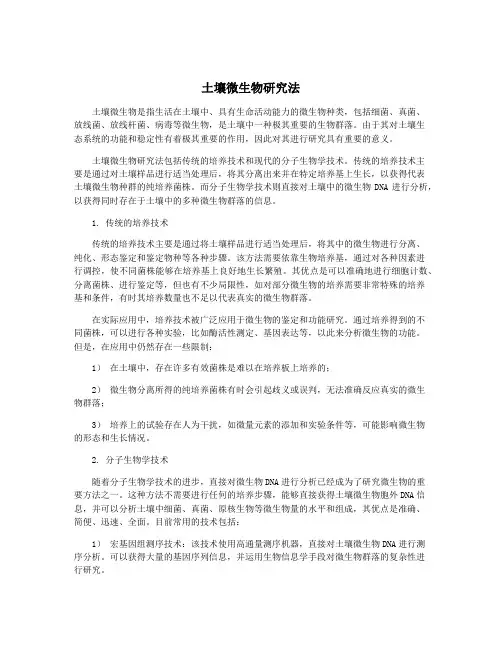
土壤微生物研究法土壤微生物是指生活在土壤中、具有生命活动能力的微生物种类,包括细菌、真菌、放线菌、放线杆菌、病毒等微生物,是土壤中一种极其重要的生物群落。
由于其对土壤生态系统的功能和稳定性有着极其重要的作用,因此对其进行研究具有重要的意义。
土壤微生物研究法包括传统的培养技术和现代的分子生物学技术。
传统的培养技术主要是通过对土壤样品进行适当处理后,将其分离出来并在特定培养基上生长,以获得代表土壤微生物种群的纯培养菌株。
而分子生物学技术则直接对土壤中的微生物DNA进行分析,以获得同时存在于土壤中的多种微生物群落的信息。
1. 传统的培养技术传统的培养技术主要是通过将土壤样品进行适当处理后,将其中的微生物进行分离、纯化、形态鉴定和鉴定物种等各种步骤。
该方法需要依靠生物培养基,通过对各种因素进行调控,使不同菌株能够在培养基上良好地生长繁殖。
其优点是可以准确地进行细胞计数、分离菌株、进行鉴定等,但也有不少局限性,如对部分微生物的培养需要非常特殊的培养基和条件,有时其培养数量也不足以代表真实的微生物群落。
在实际应用中,培养技术被广泛应用于微生物的鉴定和功能研究。
通过培养得到的不同菌株,可以进行各种实验,比如酶活性测定、基因表达等,以此来分析微生物的功能。
但是,在应用中仍然存在一些限制:1)在土壤中,存在许多有效菌株是难以在培养板上培养的;2)微生物分离所得的纯培养菌株有时会引起歧义或误判,无法准确反应真实的微生物群落;3)培养上的试验存在人为干扰,如微量元素的添加和实验条件等,可能影响微生物的形态和生长情况。
2. 分子生物学技术随着分子生物学技术的进步,直接对微生物DNA进行分析已经成为了研究微生物的重要方法之一。
这种方法不需要进行任何的培养步骤,能够直接获得土壤微生物胞外DNA信息,并可以分析土壤中细菌、真菌、原核生物等微生物量的水平和组成,其优点是准确、简便、迅速、全面。
目前常用的技术包括:1)宏基因组测序技术:该技术使用高通量测序机器,直接对土壤微生物DNA进行测序分析。

土壤微生物群落特征研究随着现代农业的迅速发展,土壤问题愈发凸显。
土壤是植物生长的根基,其中土壤微生物的数量、种类和功能是保证土壤健康的重要因素之一。
因此,研究土壤微生物群落的特征对于实现可持续农业发展至关重要。
一、土壤微生物群落的定义土壤微生物群落是指土壤中各种微生物的总体存在情况。
其中包括细菌、放线菌、真菌、原生动物和古生菌等生物,它们相互作用、繁殖和死亡,形成一个生态系统。
土壤微生物群落是土壤生态系统的重要组成部分,也是一种复杂的生物群体。
通过对土壤微生物群落的研究,可以深入了解土壤生态系统的功能以及生物间的相互作用关系。
二、土壤微生物群落的分类根据微生物的形态和生物学特征,可以将土壤微生物群落分为五类:细菌、放线菌、真菌、原生动物和古生菌。
1. 细菌细菌是土壤微生物群落中数量最多的成员。
它们通常以直线、弯曲或螺旋状形式存在,其大小在0.2至700微米之间。
细菌主要以分解有机物为生,可以通过分解复合氮、磷和其他微量元素,为植物提供必需的营养元素。
2. 放线菌放线菌是一种类似细菌的微生物,通常以线状或分支形式存在。
放线菌对土壤生态系统具有良好的调节作用,可以分解有机物、产生酶,同时也可以抑制一些有害菌种,保持土壤生态平衡。
3. 真菌真菌是一种含有细胞壁的微生物,通常以菌丝形式存活。
在土壤微生物群落中,真菌可以作为分解有机物的主要来源之一,同时也可以形成共生关系,与大多数植物形成根系真菌共生。
这种共生关系有利于植物吸收营养,提高植物的抗逆能力。
4. 原生动物原生动物是一种单细胞有机体,通常呈球形或卵圆形,大小从10至100微米不等。
在土壤微生物群落中,原生动物可以参与有机物的分解和生物循环,同时也可以对其他微生物的数量和分布产生重要影响。
5. 古生菌古生菌是一种孤立的微生物类群,原生于原始环境,其数量非常有限。
在土壤微生物群落中,古生菌主要参与有机物的分解和微量元素的循环过程。
三、土壤微生物群落特征研究进展随着现代分子生物学技术的发展,土壤微生物群落的研究越来越深入。
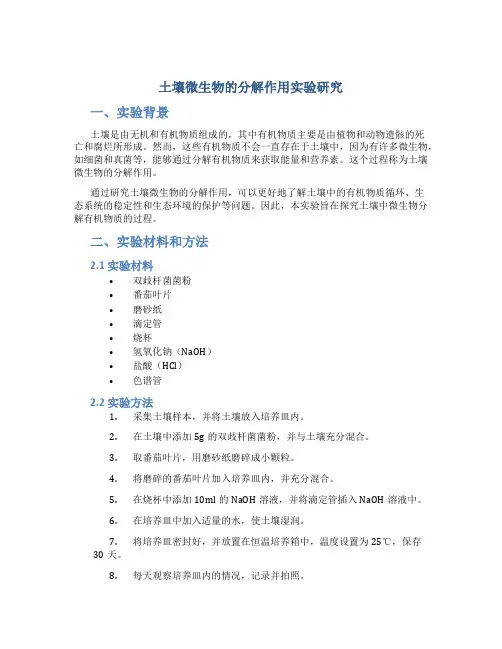
土壤微生物的分解作用实验研究一、实验背景土壤是由无机和有机物质组成的,其中有机物质主要是由植物和动物遗骸的死亡和腐烂所形成。
然而,这些有机物质不会一直存在于土壤中,因为有许多微生物,如细菌和真菌等,能够通过分解有机物质来获取能量和营养素。
这个过程称为土壤微生物的分解作用。
通过研究土壤微生物的分解作用,可以更好地了解土壤中的有机物质循环、生态系统的稳定性和生态环境的保护等问题。
因此,本实验旨在探究土壤中微生物分解有机物质的过程。
二、实验材料和方法2.1 实验材料•双歧杆菌菌粉•番茄叶片•磨砂纸•滴定管•烧杯•氢氧化钠(NaOH)•盐酸(HCl)•色谱管2.2 实验方法1.采集土壤样本,并将土壤放入培养皿内。
2.在土壤中添加5g的双歧杆菌菌粉,并与土壤充分混合。
3.取番茄叶片,用磨砂纸磨碎成小颗粒。
4.将磨碎的番茄叶片加入培养皿内,并充分混合。
5.在烧杯中添加10ml的NaOH溶液,并将滴定管插入NaOH溶液中。
6.在培养皿中加入适量的水,使土壤湿润。
7.将培养皿密封好,并放置在恒温培养箱中,温度设置为25℃,保存30天。
8.每天观察培养皿内的情况,记录并拍照。
9.将培养皿中的样品取出,挥发水分,然后进行质量分析。
10.对样品进行分析时,可以使用气相色谱(GC)和质谱(MS)等设备进行分析,以确定分解产物的类型和含量。
三、实验结果经过30天的培养,观察发现土壤中的番茄叶片明显减少,形态也发生了变化。
在实验的早期阶段,番茄叶片被微生物附着和固定在土壤表面,但在后期,叶片被完全分解并转变为土壤中的有机物质。
根据样品检测结果,可以发现产生了大量的有机酸(如苹果酸和柠檬酸)和糖类物质。
这些物质不仅可以为微生物提供能量和营养,还可以为土壤提供养分和改善土壤质量。
四、实验结论通过本实验的研究,可以得出以下结论:1.土壤中微生物参与了有机物质的分解过程,将有机物质分解成简单的有机酸和糖类物质。
2.分解产物可以为微生物和土壤提供能量和养分,有助于保持生态系统的稳定性和提高土壤的质量。
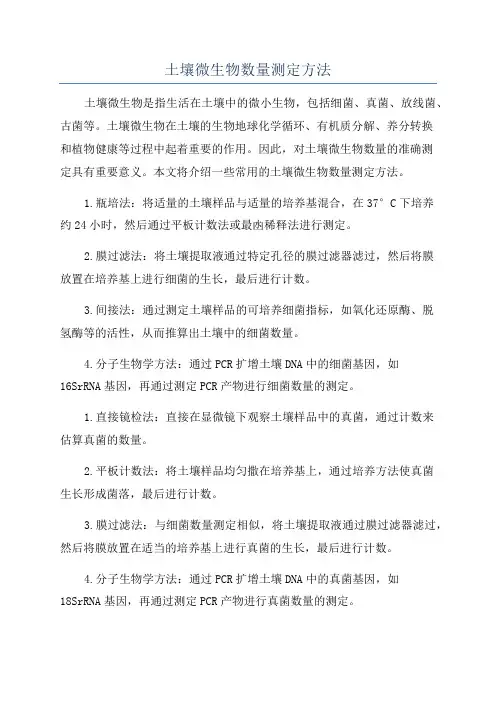
土壤微生物数量测定方法土壤微生物是指生活在土壤中的微小生物,包括细菌、真菌、放线菌、古菌等。
土壤微生物在土壤的生物地球化学循环、有机质分解、养分转换和植物健康等过程中起着重要的作用。
因此,对土壤微生物数量的准确测定具有重要意义。
本文将介绍一些常用的土壤微生物数量测定方法。
1.瓶培法:将适量的土壤样品与适量的培养基混合,在37°C下培养约24小时,然后通过平板计数法或最凼稀释法进行测定。
2.膜过滤法:将土壤提取液通过特定孔径的膜过滤器滤过,然后将膜放置在培养基上进行细菌的生长,最后进行计数。
3.间接法:通过测定土壤样品的可培养细菌指标,如氧化还原酶、脱氢酶等的活性,从而推算出土壤中的细菌数量。
4.分子生物学方法:通过PCR扩增土壤DNA中的细菌基因,如16SrRNA基因,再通过测定PCR产物进行细菌数量的测定。
1.直接镜检法:直接在显微镜下观察土壤样品中的真菌,通过计数来估算真菌的数量。
2.平板计数法:将土壤样品均匀撒在培养基上,通过培养方法使真菌生长形成菌落,最后进行计数。
3.膜过滤法:与细菌数量测定相似,将土壤提取液通过膜过滤器滤过,然后将膜放置在适当的培养基上进行真菌的生长,最后进行计数。
4.分子生物学方法:通过PCR扩增土壤DNA中的真菌基因,如18SrRNA基因,再通过测定PCR产物进行真菌数量的测定。
1.直接镜检法:直接在显微镜下观察土壤样品中的放线菌,通过计数来估算放线菌的数量。
2.平板计数法:将土壤样品均匀撒在培养基上,通过培养方法使放线菌生长形成菌落,最后进行计数。
3.膜过滤法:与细菌和真菌数量测定类似,将土壤提取液通过膜过滤器滤过,然后将膜放置在适当的培养基上进行放线菌的生长,最后进行计数。
4.分子生物学方法:通过PCR扩增土壤DNA中的放线菌基因,如16SrRNA基因,再通过测定PCR产物进行放线菌数量的测定。
通过上述方法测定土壤中微生物的数量,可以了解土壤微生物对土壤生态系统功能的影响,并为土壤质量评价和科学合理利用提供依据。

模拟土壤微生物摇瓶培养法摇瓶培养法是一种常用的土壤微生物研究方法,可以用来定量评估土壤中微生物的数量和活性。
本文将介绍模拟土壤微生物摇瓶培养法的基本原理、步骤和注意事项。
一、摇瓶培养法的基本原理摇瓶培养法是通过将土壤样品与培养基混合在摇瓶中,培养一定时间后,通过计数培养瓶中微生物的数量来评估土壤微生物的多寡。
在培养过程中,土壤样品中的微生物会通过代谢活动产生可见的变化,如产酸、产气等,从而可以通过观察这些变化来评估微生物的数量和活性。
二、摇瓶培养法的步骤1.准备土壤样品:从研究对象的土壤中采集一定量的样品,避免采集过程中的污染。
样品应随机采集,保证代表性。
2.制备培养基:根据研究需要选择适当的培养基,如常用的液体培养基包括液体肉汤培养基、液体琼脂培养基等。
制备培养基时应严格按照配方和操作要求进行。
3.摇瓶培养:将土壤样品与培养基混合均匀后注入摇瓶中,摇瓶培养一定时间。
培养时间一般为24小时至72小时,根据研究需要进行调整。
4.观察和计数:培养结束后,观察培养瓶中是否有可见的变化,如产酸或产气等。
根据需要,可以进行进一步的计数工作,如使用显微镜计数或进行菌落计数。
5.数据分析:根据观察和计数结果,可以评估土壤微生物的数量和活性,并进行数据统计和分析。
三、摇瓶培养法的注意事项1.样品处理:在采集和处理样品的过程中,要避免污染和氧化,以免影响微生物的生长和代谢活动。
2.培养基选择:根据研究对象和目的选择适当的培养基,以促进微生物的生长和代谢。
3.培养条件控制:在培养过程中,要控制好温度、pH值、湿度等条件,以提供适宜的生长环境。
4.摇瓶方式:在培养过程中,要根据研究需要选择适当的摇瓶方式,如旋转摇瓶、摇床摇瓶等,以促进培养基和微生物的充分接触。
5.观察和计数方法:观察和计数时要仔细、准确,尽量避免主观误差。
可以使用显微镜计数、菌落计数或其他适当的方法进行。
6.数据处理和分析:在数据处理和分析时,要注意统计学方法的选择和正确应用,以得出准确和可靠的结果。

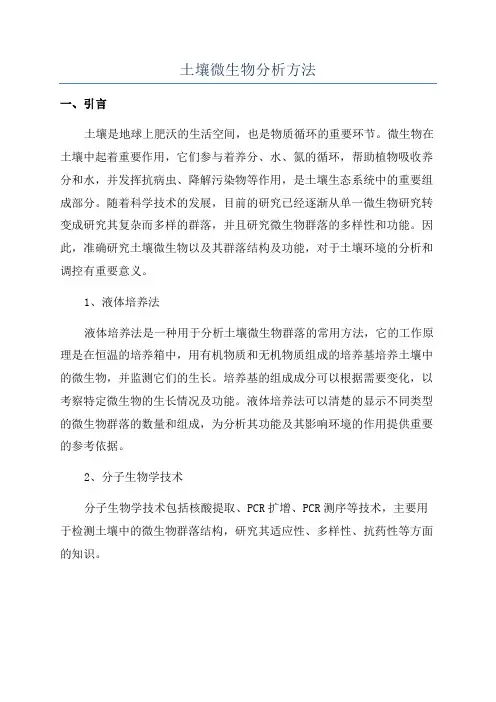
土壤微生物分析方法
一、引言
土壤是地球上肥沃的生活空间,也是物质循环的重要环节。
微生物在土壤中起着重要作用,它们参与着养分、水、氮的循环,帮助植物吸收养分和水,并发挥抗病虫、降解污染物等作用,是土壤生态系统中的重要组成部分。
随着科学技术的发展,目前的研究已经逐渐从单一微生物研究转变成研究其复杂而多样的群落,并且研究微生物群落的多样性和功能。
因此,准确研究土壤微生物以及其群落结构及功能,对于土壤环境的分析和调控有重要意义。
1、液体培养法
液体培养法是一种用于分析土壤微生物群落的常用方法,它的工作原理是在恒温的培养箱中,用有机物质和无机物质组成的培养基培养土壤中的微生物,并监测它们的生长。
培养基的组成成分可以根据需要变化,以考察特定微生物的生长情况及功能。
液体培养法可以清楚的显示不同类型的微生物群落的数量和组成,为分析其功能及其影响环境的作用提供重要的参考依据。
2、分子生物学技术
分子生物学技术包括核酸提取、PCR扩增、PCR测序等技术,主要用于检测土壤中的微生物群落结构,研究其适应性、多样性、抗药性等方面的知识。
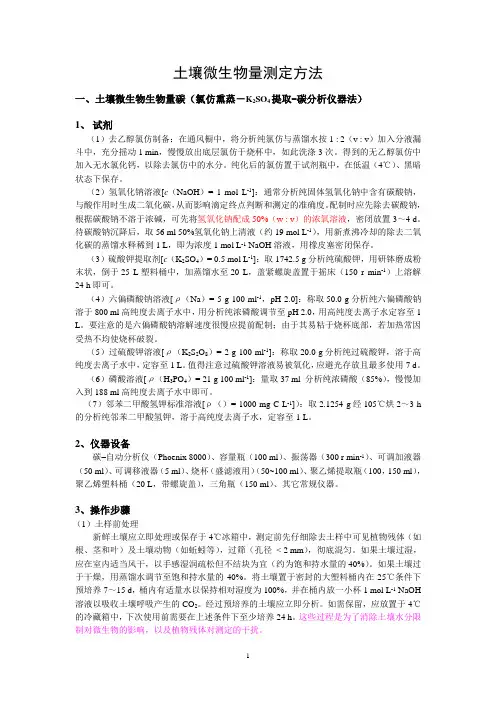
土壤微生物量测定方法一、土壤微生物生物量碳(氯仿熏蒸-K2SO4提取-碳分析仪器法)1、试剂(1)去乙醇氯仿制备:在通风橱中,将分析纯氯仿与蒸馏水按1 2(v : v)加入分液漏斗中,充分摇动1 min,慢慢放出底层氯仿于烧杯中,如此洗涤3次。
得到的无乙醇氯仿中加入无水氯化钙,以除去氯仿中的水分。
纯化后的氯仿置于试剂瓶中,在低温(4℃)、黑暗状态下保存。
(2)氢氧化钠溶液[c(NaOH)= 1 mol L-1]:通常分析纯固体氢氧化钠中含有碳酸钠,与酸作用时生成二氧化碳,从而影响滴定终点判断和测定的准确度。
配制时应先除去碳酸钠,根据碳酸钠不溶于浓碱,可先将氢氧化钠配成50%(w : v)的浓氧溶液,密闭放置3~4 d。
待碳酸钠沉降后,取56 ml 50%氢氧化钠上清液(约19 mol L-1),用新煮沸冷却的除去二氧化碳的蒸馏水释稀到1 L,即为浓度1 mol L-1 NaOH溶液,用橡皮塞密闭保存。
(3)硫酸钾提取剂[c(K2SO4)= 0.5 mol L-1]:取1742.5 g分析纯硫酸钾,用研钵磨成粉末状,倒于25 L塑料桶中,加蒸馏水至20 L,盖紧螺旋盖置于摇床(150 r min-1)上溶解24 h即可。
(4)六偏磷酸钠溶液[ρ(Na)= 5 g 100 ml-1,pH 2.0]:称取50.0 g分析纯六偏磷酸钠溶于800 ml高纯度去离子水中,用分析纯浓磷酸调节至pH 2.0,用高纯度去离子水定容至1 L。
要注意的是六偏磷酸钠溶解速度很慢应提前配制;由于其易粘于烧杯底部,若加热常因受热不均使烧杯破裂。
(5)过硫酸钾溶液[ρ(K2S2O8)= 2 g 100 ml-1]:称取20.0 g分析纯过硫酸钾,溶于高纯度去离子水中,定容至1 L。
值得注意过硫酸钾溶液易被氧化,应避光存放且最多使用7 d。
(6)磷酸溶液[ρ(H3PO4)= 21 g 100 ml-1]:量取37 ml 分析纯浓磷酸(85%),慢慢加入到188 ml高纯度去离子水中即可。
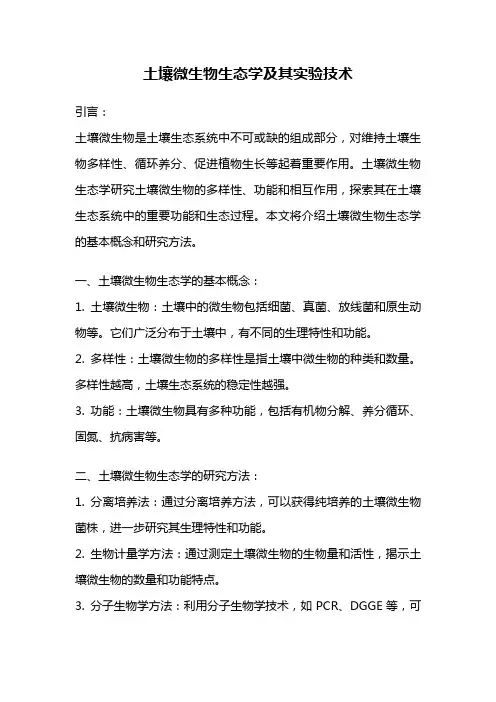
土壤微生物生态学及其实验技术引言:土壤微生物是土壤生态系统中不可或缺的组成部分,对维持土壤生物多样性、循环养分、促进植物生长等起着重要作用。
土壤微生物生态学研究土壤微生物的多样性、功能和相互作用,探索其在土壤生态系统中的重要功能和生态过程。
本文将介绍土壤微生物生态学的基本概念和研究方法。
一、土壤微生物生态学的基本概念:1. 土壤微生物:土壤中的微生物包括细菌、真菌、放线菌和原生动物等。
它们广泛分布于土壤中,有不同的生理特性和功能。
2. 多样性:土壤微生物的多样性是指土壤中微生物的种类和数量。
多样性越高,土壤生态系统的稳定性越强。
3. 功能:土壤微生物具有多种功能,包括有机物分解、养分循环、固氮、抗病害等。
二、土壤微生物生态学的研究方法:1. 分离培养法:通过分离培养方法,可以获得纯培养的土壤微生物菌株,进一步研究其生理特性和功能。
2. 生物计量学方法:通过测定土壤微生物的生物量和活性,揭示土壤微生物的数量和功能特点。
3. 分子生物学方法:利用分子生物学技术,如PCR、DGGE等,可以研究土壤微生物的多样性和群落结构。
4. 同位素示踪法:通过同位素标记技术,可以追踪土壤微生物在土壤生态系统中的功能和相互作用。
5. 生态学模型:利用生态学模型,可以模拟和预测土壤微生物的分布和功能。
三、土壤微生物生态学的研究内容:1. 土壤微生物多样性:研究土壤微生物的多样性,探索其影响因素和生态功能。
2. 土壤微生物功能:研究土壤微生物的功能特点,如有机物分解、养分循环、固氮等。
3. 土壤微生物群落结构:研究土壤微生物的群落结构和变化规律,揭示其对环境变化的响应。
4. 土壤微生物与植物互作:研究土壤微生物与植物之间的相互作用,探索其对植物生长和健康的影响。
5. 土壤微生物生态功能评价:评价土壤微生物对土壤生态系统功能的贡献和稳定性。
结论:土壤微生物生态学是研究土壤微生物的多样性、功能和相互作用的学科,具有重要的理论和应用价值。
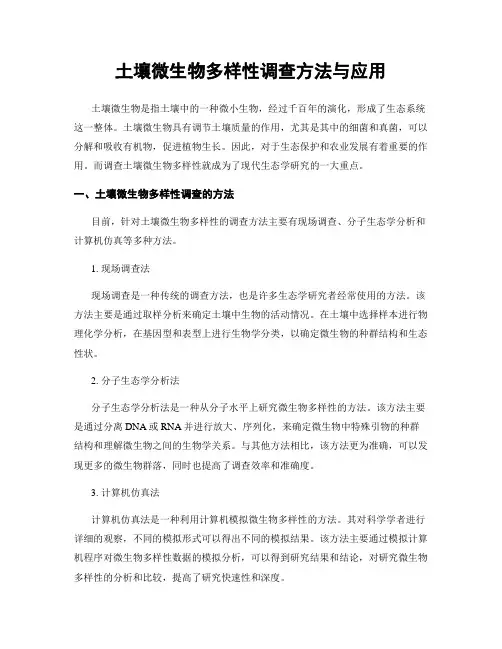
土壤微生物多样性调查方法与应用土壤微生物是指土壤中的一种微小生物,经过千百年的演化,形成了生态系统这一整体。
土壤微生物具有调节土壤质量的作用,尤其是其中的细菌和真菌,可以分解和吸收有机物,促进植物生长。
因此,对于生态保护和农业发展有着重要的作用。
而调查土壤微生物多样性就成为了现代生态学研究的一大重点。
一、土壤微生物多样性调查的方法目前,针对土壤微生物多样性的调查方法主要有现场调查、分子生态学分析和计算机仿真等多种方法。
1. 现场调查法现场调查是一种传统的调查方法,也是许多生态学研究者经常使用的方法。
该方法主要是通过取样分析来确定土壤中生物的活动情况。
在土壤中选择样本进行物理化学分析,在基因型和表型上进行生物学分类,以确定微生物的种群结构和生态性状。
2. 分子生态学分析法分子生态学分析法是一种从分子水平上研究微生物多样性的方法。
该方法主要是通过分离DNA或RNA并进行放大、序列化,来确定微生物中特殊引物的种群结构和理解微生物之间的生物学关系。
与其他方法相比,该方法更为准确,可以发现更多的微生物群落,同时也提高了调查效率和准确度。
3. 计算机仿真法计算机仿真法是一种利用计算机模拟微生物多样性的方法。
其对科学学者进行详细的观察,不同的模拟形式可以得出不同的模拟结果。
该方法主要通过模拟计算机程序对微生物多样性数据的模拟分析,可以得到研究结果和结论,对研究微生物多样性的分析和比较,提高了研究快速性和深度。
二、土壤微生物多样性调查的意义1. 保护生态系统健康通过调查土壤中微生物多样性,可以评估土壤的生态质量,对于土壤生态疾病、物理和化学因素的影响有着重要的指导意义。
同时,可以对土壤质量进行科学监测,保护生态系统,维护生态平衡。
2. 提高土地利用率对于开发和利用耕地资源,了解土壤中存在的微生物的特征和生长情况,可以对其进行指导,提高土地利用率,增加农业生产效益,同时也可以保护土地生态系统的完整性。
3. 促进精准农业了解土壤中存在的微生物种类和分布情况,可以更好地利用先进的土壤检测技术,制定更为合理的农作物种植和肥料施用方案,从而提高农作物的产量质量,实现农业的可持续发展。
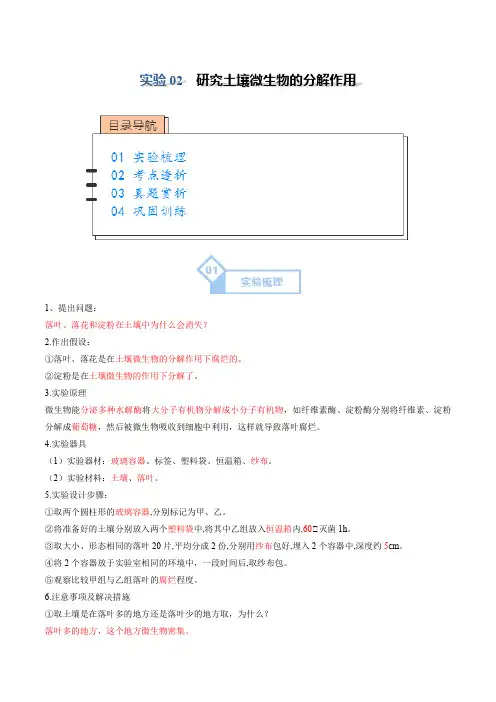
实验02研究土壤微生物的分解作用1、提出问题:落叶、落花和淀粉在土壤中为什么会消失?2.作出假设:①落叶、落花是在土壤微生物的分解作用下腐烂的。
②淀粉是在土壤微生物的作用下分解了。
3.实验原理微生物能分泌多种水解酶将大分子有机物分解成小分子有机物,如纤维素酶、淀粉酶分别将纤维素、淀粉分解成葡萄糖,然后被微生物吸收到细胞中利用,这样就导致落叶腐烂。
4.实验器具(1)实验器材:玻璃容器、标签、塑料袋、恒温箱、纱布。
(2)实验材料:土壤、落叶。
5.实验设计步骤:①取两个圆柱形的玻璃容器,分别标记为甲、乙。
②将准备好的土壤分别放入两个塑料袋中,将其中乙组放入恒温箱内,60℃灭菌1h。
③取大小、形态相同的落叶20片,平均分成2份,分别用纱布包好,埋入2个容器中,深度约5cm。
④将2个容器放于实验室相同的环境中,一段时间后,取纱布包。
⑤观察比较甲组与乙组落叶的腐烂程度。
6.注意事项及解决措施①取土壤是在落叶多的地方还是落叶少的地方取,为什么?落叶多的地方,这个地方微生物密集。
②取表层土还是深层土?为什么? 取表层土,大部分微生物进行有氧呼吸。
③该实验的自变量,因变量是什么?自变量是微生物的有无,因变量是落叶的腐烂程度。
④甲、乙两组哪个是对照组,哪个是实验组? 甲组是对照组,乙组是实验组。
⑤试验中无关变量有哪些? 温度,水分,空气。
7.实验结果记录表 组别 腐烂程度 天数 0d4d8d12d16d甲组 乙组8.用坐标曲线表示实验结果(以天数为横坐标,腐烂程度为纵坐标)9.实验报告示例 班级 姓名实验日期 实验名称指导教师一、实验目的:二、实验原理:三、实验用品四、实验结果及步骤腐烂 程 度时间(天) 0 48 12 16①实验结果:16d后从土壤中取出纱布包观察落叶,预期结果是:甲组:落叶腐烂;乙组:落叶不腐烂(或略有腐烂)②实验结论:落叶是在土壤微生物的分解作用下腐烂的。
11.问题探讨:①相同时间内甲组落叶的腐烂程度大于乙组,说明了什么?微生物对落叶有分解作用。
土壤微生物研究原理与方法土壤微生物是指存在于土壤中的微小生物体,包括细菌、真菌、放线菌、古菌、原生生物等。
它们在土壤中扮演着重要的角色,参与有机物质的分解、养分循环以及土壤生物活性等过程。
因此,研究土壤微生物对于理解土壤生态系统的功能和稳定性具有重要意义。
本文将介绍土壤微生物研究的原理和方法。
1. 土壤微生物研究原理土壤微生物研究的原理主要包括以下几个方面:(1)微生物群落结构:土壤微生物群落结构是指土壤中微生物的种类组成和数量分布。
通过研究微生物群落结构,可以了解土壤微生物的多样性和功能多样性,揭示微生物之间的相互作用和对土壤环境的响应。
(2)微生物代谢活性:微生物在土壤中的代谢活性反映了其对有机质和养分的利用能力。
通过研究土壤微生物的代谢活性,可以评估土壤微生物的生物量和活性,从而了解土壤的新陈代谢情况。
(3)微生物的生态功能:微生物在土壤生态系统中具有多种生态功能,包括有机质的分解、养分的转化和循环、抗生素的合成等。
研究微生物的生态功能可以揭示微生物与土壤环境之间的相互作用和影响,为土壤养分管理和生态系统恢复提供理论支持。
2. 土壤微生物研究方法土壤微生物研究方法主要包括土壤微生物的提取和分离、微生物群落结构的分析、微生物代谢活性的测定以及微生物的生态功能评价等。
(1)土壤微生物的提取和分离:土壤中微生物的提取和分离是研究土壤微生物的第一步。
常用的方法包括土壤样品的稀释平板法、渗滤法、摇瓶培养法以及膜过滤法等。
对于某些特定微生物群落的研究,可以选择特定的培养基和培养条件,以分离出目标微生物。
(2)微生物群落结构的分析:微生物群落结构的分析常用的方法有生物多样性测定方法(如PCR-DGGE、PCR-TGGE、16S rRNA基因测序等)、荧光原位杂交(FISH)技术、下一代测序技术(NGS)等。
这些方法可以帮助我们了解土壤微生物的多样性、种类和数量分布。
(3)微生物代谢活性的测定:微生物代谢活性的测定常用的方法有农业基础磷酸酶活性测定法、氢氧化酶活性测定法、呼吸代谢测定法、膜透性测定法等。
土 壤 (Soils), 2004, 36 (4): 346~350土壤微生物多样性实验研究方法概述 章家恩 蔡燕飞 高爱霞 朱丽霞 (华南农业大学热带亚热带生态研究所广州 510642)摘 要对有关土壤微生物多样性,包括微生物类群多样性、群落结构多样性、功能多样性以及基因多样性等的描述与表征方法进行了探讨,同时,对当前国内外土壤微生物多样性的一些实验研究方法,包括土壤微生物分离培养方法、Biolog微平板方法、FAME分析方法和分子生物学方法等进行了介绍和评述。
并指出在土壤微生物多样性研究中,如果可能的话,需要将各种方法结合起来使用,方可得到有关土壤生物多样性的较为全面的信息和理解。
关键词土壤微生物;生物多样性;FAME;Biolog;PCR中图分类号 Q938.1;S154.36生物多样性是当今国际上共同关注的问题,它也因此日益成为学术界的热点研究领域之一。
目前在地上部植物和动物的多样性方面开展了大量的研究,但对土壤生物多样性,特别是在土壤微生物多样性方面的研究仍较薄弱。
其中一个重要的原因就是在土壤微生物多样性的研究方法方面还存在着较大的困难和缺陷,很多方法还不能全面地、准确地研究土壤微生物多样性状况。
为此,本文对当前国内外土壤微生物多样性研究方法进行概述,旨在为相关研究提供一些参考。
1 土壤微生物多样性的表示方法 生态学意义上的“生物多样性”是指生物与环境形成的生态复合体以及与此相关的各种生态过程的总和,一般包括遗传多样性、物种多样性和生态系统多样性3个层次[1]。
生物多样性通常用“多样性指数”来表示。
生物(物种)多样性指数的计算一般需要知道群落中物种的种数以及各物种的个体数等相关的信息。
对于土壤微生物,由于方法上的限制和微生物自身的变异性,目前还不可能将土壤中的全部微生物培养出来,而且对于土壤微生物种属的鉴定分类也是一件不易的工作。
因此,在实际研究中,通常从某一侧面或某一角度来近似或间接地描述土壤微生物的多样性状况。
土壤微生物研究原理与方法
土壤微生物是指土壤中的各种微生物,包括细菌、真菌、放线菌、原生动物等。
它们具有重要的生态功能,既能参与物质循环、能量流动、土壤形成和保护等生态过程,又能影响和调节植物生长、土壤质
量和健康、环境污染的治理等方面。
土壤微生物研究的基本原理是通过采集土壤样品,利用分离、鉴定、计数、培养等方法,对不同类型和功能的微生物进行定量和定性
分析,了解其种类、密度、活性、分布等特征以及与土壤环境和作物
生长等因素的关系。
常用的研究方法包括:
1.分离鉴定法:采用分离平板或液体培养基,将土壤样品培养出
不同的微生物单菌种,再通过形态、生理、生化等特性进行种属鉴定。
2.实时荧光定量PCR法:利用荧光定量PCR技术,结合适当的基
因或序列作为指示剂,可以快速准确地定量目标微生物的数量。
3.微生物生态学方法:通过土壤酶活性、氧化还原电位、pH值、养分含量等环境因子,综合评估土壤微生物群落的结构和功能。
4.组学(metagenomcis)方法:通过高通量测序技术,分析土壤
微生物群落的多样性、代谢途径、基因功能等方面的信息,可以快速、全面地揭示土壤微生物的谱系和功能。
综合应用上述方法,可以深入研究土壤微生物群落与环境、土壤
健康、农业可持续发展、生态安全等方面的关系,为促进农业发展和
生态环境保护提供科学依据。
土壤微生物生物量的测定方法氯仿熏蒸氯仿熏蒸法是一种在实验室中用氯仿处理土壤样品,然后测定氯仿处理前后土壤微生物生物量差异的方法。
通过加入氯仿,能够杀死土壤中的微生物,从而减少微生物的数量,然后利用一些生物学或化学方法来测定残留的微生物生物量。
氯仿熏蒸法的步骤如下:1.准备土壤样品:将采集到的土壤样品经过干燥和破碎,使其能够尽可能均匀地参与后续的熏蒸过程。
2.加入氯仿溶液:将准备好的土壤样品分装到烧杯或烧瓶中,加入一定比例的氯仿溶液。
氯仿的浓度一般为10%~30%,取决于土壤类型和研究目的。
3.熏蒸土样:将装有土壤和氯仿溶液的容器密封,熏蒸一定的时间。
通常熏蒸时间为24~48小时。
4.蒸发氯仿:打开容器,在通风条件良好的环境中将氯仿挥发,一直蒸发到气味完全消失。
5.提取微生物细胞:将氯仿处理后的土壤样品用适当的提取剂提取,以从土壤中提取微生物细胞。
6.测定微生物生物量:使用适当的方法,如直接计数法、生物量焦磷酸法或基于生物标记物的测定法,来测定氯仿处理前后土壤样品中微生物生物量的差异。
氯仿熏蒸法的优点是操作简单、成本低廉,并且对土壤样品中的细菌、真菌和原生动物等各类微生物都具有较好的破壁效果,能够有效地杀灭土壤中的微生物。
同时,氯仿处理还可以去除土壤样品中的有机物质,从而减少后续测定中的干扰。
然而,氯仿熏蒸法也存在一些局限性。
首先,由于氯仿是一种有机溶剂,熏蒸过程中可能对土壤样品的结构和性质造成一定的改变。
其次,氯仿处理只能杀灭土壤中的微生物,对于土壤中的其他生物物种如线虫、螨虫等则不具备同样的杀灭效果。
此外,氯仿熏蒸法只能提供微生物生物量的总量信息,无法区分不同类群的微生物。
总结起来,氯仿熏蒸法是测定土壤微生物生物量的一种常用方法,其操作简便、费用低廉,且能够有效地杀灭土壤中的微生物。
但需要注意的是,在实际应用中要综合考虑其局限性,并根据研究目的选择合适的测定方法。
土壤微生物量及土壤酶活性测定方法土壤中的微生物是维持土壤生态系统健康的重要组成部分,土壤酶活性则可以作为评价土壤肥力和生物活性的重要指标。
因此,在土壤微生物量和土壤酶活性测定方面的研究非常重要。
本文将介绍几种常用的土壤微生物量和土壤酶活性的测定方法。
一、土壤微生物量测定方法1.铺平法:将土壤样品铺平在玻璃板上,使用显微镜对土壤中的微生物进行直接观察和计数。
这种方法的优点是简单易行,但需要大量的时间和人力。
2.累积碳法:通过测定土壤中的有机碳含量来间接估算土壤微生物量。
有机碳水平与微生物量密切相关,所以可以通过测定土壤中的有机碳来推测微生物的数量和活性。
3.培养法:将土壤样品接种到适当的培养基上进行培养,然后通过菌落计数或直接计数来估算微生物的数量。
这种方法适用于数量较多的微生物,如细菌和真菌。
4.傅里叶变换红外光谱法(FTIR):通过测量土壤样品的傅里叶变换红外光谱,分析土壤中的微生物量。
该方法具有快速、准确、非破坏性等优点。
1.浊液法:通过观察测定液中的混浊度来测定土壤中的脲酶、过氧化氢酶等氧化酶的活性。
这种方法简单易行,但对于不同种类的土壤酶效果不一样。
2.比色法:采用酶底物与酶催化产物之间的化学反应,通过测定反应产物的颜色来估算土壤酶活性。
比色法可以用于测定脱氢酶、脱氢酶、脱氧核苷酸酶等酶的活性。
3.荧光法:将有机物和荧光试剂一起加入土壤样品中,经过反应后,在荧光分析仪中测定产生的荧光强度来测定土壤酶的活性。
荧光法适用于测定蔗糖酶、酚氧化酶和脱氢酶等酶的活性。
4.比浊法:通过加入酶底物后,观察土壤样品的混浊度来测定土壤中酶的活性。
比浊法适用于黄酶、脱氢酶等酶的活性测定。
5.电导法:通过测定土壤样品溶液中的电导率变化来估算土壤中酶的活性。
电导法适用于磷酸酶和脱氢酶等酶的活性测定。
总结起来,土壤微生物量和土壤酶活性的测定方法多种多样,选择合适的方法需要考虑样品特性和实验条件等因素。
每种方法都有其优点和局限性,研究者应根据需要选取合适的方法进行测定。
土壤微生物多样性研究土壤微生物是地球上最丰富的生物群体之一,是负责生态系统功能的重要组成部分。
同时,土壤微生物多样性也是构成生态系统稳定性的关键因素。
因此,研究土壤微生物多样性对于保护生态环境和提升土地质量具有重要意义。
一、土壤微生物多样性的定义土壤微生物多样性是指在土壤中存在的各种微生物的多样性,其中包括细菌、真菌、原生动物、线虫和病毒等。
这些微生物种类繁多,数量庞大,它们在土壤中发挥着不同的作用。
二、土壤微生物多样性的重要性土壤微生物多样性是维持生态系统功能的重要保障。
土壤中微生物种类的多样性,可以促进生态系统中的营养循环、有机物分解和流量调节等生态过程的进行。
同时,不同的微生物还能够互相作用,形成复杂的生态网络,使生态系统更加稳定。
土壤微生物多样性也对生态系统的环境调节起着重要作用。
微生物通过分解有机物,促进土壤肥力的提高。
而在种植业和农业中,微生物也能够对作物生长起到促进或者保护的作用。
而且,微生物对二氧化碳的吸收、氧气的释放和土壤的固碳也有显著的贡献。
三、土壤微生物多样性研究方法研究土壤微生物多样性的方法包括了分子生物学、生态学和计算模型等。
其中,最常用的方法是将样品中的DNA提取出来,然后进行PCR扩增和后续的高通量测序。
这样可以通过进化树或遗传距离矩阵分析,得出土壤原生动物和细菌等微生物的物种数目和多样性指数等参数。
同时,生态学和计算模型也为研究微生物多样性提供了理论基础。
研究人员可以利用土壤物理化学性质和环境因素等,构建简单模型或复杂模型,分析微生物的分布和多样性的规律。
四、土壤微生物多样性研究的应用发展随着技术的进步和研究的深入,土壤微生物多样性的研究也开拓了更多的应用领域。
其中,最显著的一点是在保护生态环境和治理污染方面。
研究人员通过对菌群结构的了解,发现某些微生物能够分解有机物,净化水体和尾矿等。
因此,通过调整种群结构和加强有益微生物的作用,就能达到治理污染的目标。
另外,研究土壤微生物多样性还可以为生物技术和生物工作提供理论支持。
Pedobiologia 50(2006)275—280SHORT COMMUNICATIONChoice of methods for soil microbial community analysis:PLFA maximizes power compared to CLPP and PCR-based approachesPhilip W.Ramsey a,Ã,Matthias C.Rillig a ,Kevin P .Feris b ,William E.Holben a ,James E.Gannon aa Microbial Ecology Program,Division of Biological Sciences,The University of Montana,USA bDepartment of Biology,Boise State University,USAReceived 11January 2006;received in revised form 6March 2006;accepted 9March 2006KEYWORDS Polyphasic;Phospholipid fatty acid;PLFA;Community level physiological profiling;CLPP;PCRSummaryPolyphasic studies that used phospholipid fatty acid analysis (PLFA)in conjunction with community level physiological profiling (CLPP)or PCR-based molecular methods were analyzed in order to evaluate the power of each strategy to detect treatment effects on soil microbial community structure (MCS).We found no studies where CLPP or PCR-based methods differentiated treatments that were not also differentiated by PLFA.In 14of 32studies (44%),PLFA differentiated treatments that were not resolved by CLPP analysis.In 5of 25studies (20%),PLFA differentiated treatments that were not resolved by PCR-based methods.We discuss PLFA,CLPP ,and PCR-based methods with respect to power to discriminate change in MCS versus potential for characterization of underlying population level changes.&2006Elsevier GmbH.All rights reserved.The response of soil microbial community struc-ture (MCS)to perturbation is of interest to researchers seeking biologically relevant variables in experimentally or naturally altered ecosystems.For the current discussion,MCS is defined as the number and relative abundance of microbialpopulations in soil.Three strategies for the elucidation of treatment effects on MCS dominate contemporary Microb.Ecol.:community level physiological profiling (CLPP),phospholipid fatty acid analysis (PLFA),and PCR-based methods such as denaturing gradient gel electrophoresis (DGGE),terminal restriction fragment length polymorphism (T-RFLP),ribosomal intergenic spacer analysis (RISA),and randomly amplified polymorphic DNA(RAPD)(Øvre (as,2000).Independent assessments have indicated that each approach returns similar results with respect to the demonstration ofwww.elsevier .de/pedobi0031-4056/$-see front matter &2006Elsevier GmbH.All rights reserved.doi:10.1016/j.pedobi.2006.03.003ÃCorresponding author .Tel.:+14062434254.E-mail addresses:philip@ (P .W.Ramsey),matthias@ (M.C.Rillig),kevinferis@ (K.P .Feris),bill.holben@ (W.E.Holben),jim.gannon@ (J.E.Gannon).treatment effects(Widmer et al.,2001;Ritchie et al.,2000).The relative power of each to elucidate treatment effects has rarely been com-pared.In one study,PLFA was demonstrated to be more sensitive than CLPP and a PCR-based method (guanine plus cytosine ratio)to changes in MCS across a gradient of grassland management inten-sities(Grayston et al.,2004).In another study,the ability of PLFA and a molecular method,length heterogeneity PCR(LH-PCR),to resolve the effects of tillage and ground cover on MCS were compared using discriminant analysis(Dierksen et al.,2002). In that study,the inclusion of molecular data into the discriminant analysis did not improve predic-tive power of the analysis above that which was achieved using PLFA data alone.This study raises the hypothesis that using a polyphasic approach to detect change in MCS is no more useful than PLFA data alone.Here,we tested this hypothesis by searching for studies that used PLFA in conjunction with CLPP or PCR-based methods in order to evaluate the question:Has CLPP or a PCR-based method been used to detect a treatment effect on MCS that was not also detectable by PLFA? Searches of the Web of Science and CSA Illumina databases with various combinations of the words PLFA,FAME,CLPP,fatty acids,T-RFLP,Biolog s, DNA,PCR,16s,rDNA,DGGE,TGGE,gel electro-phoresis,soil,community structure,and polyphasic returned53studies that used PLFA in conjunction with CLPP or PCR-based methods to identify treatment effects on MCS.While not exhaustive, the highest impact factor soils journals were among the journals included(see references in Table1). Therefore,the sample should represent the current state of knowledge.Papers in which PCR-based methods were used to track specific populations either by DGGE band excision and sequencing or by the use of primer sets specific to phylogenetic groups were not considered to be demonstrations of change in MCS unless including a general test of significant difference(or correlation)at the total community level.No studies were found where CLPP or PCR-based analyses were used to differentiate a treatment effect on soil MCS that was not also identified by PLF A of the same samples.Conversely,in14of32 studies(44%),PLF A differentiated treatments that were not resolved by CLPP analysis of the same samples.In5of25studies(20%),PLF A differentiated treatments that were not resolved by a PCR-based method.These studies are arranged categorically in T able1.In thefive studies where PCR-based methods were unable to detect differences detected by PLF A,the specific PCR-based methods used were LH-PCR,DGGE(twice),RISA,and DNA RAPD(Dierk-sen et al.,2002;Thirup et al.,2003;Leckie et al., 2004;Ritz et al.,2004;Suhadolc et al.,2004).If the MCS changes detected by PLFA are real in all cases, our analysis implies that studies using only CLPP or a PCR-based method incur a type II error rate of approximately44%and20%,respectively.Of the three general strategies for detecting MCS changes,PCR-based methods are used in a higher proportion of studies than PLFA or CLPP(Fig.1), probably because PCR-based methods offer the greatest potential for characterization of under-lying population level changes.However,the power of PCR-based methods to resolve treatment effects on the total soil microbial community may be limited compared to PLFA because less statistically relevant information can be gained from pattern analysis of PCR-generatedfingerprint patterns than from PLFA profiles.One explanation of this is that in a typical DGGE analysis,20–50detectable and quantifiable bands may vary in intensity by one or two orders of magnitude(due to detection and imaging limitations),while in a typical PLFA profile more than70continuous variables(PLFA peaks)can be detected in concentrations ranging over at least 3orders of magnitude.Further,quantitative estimates of population densities gleaned from community level analyses must be considered carefully due to so-called‘‘PCR bias’’introduced by the exponential amplification of DNA targets. Rarefaction analysis of molecular data allows estimates of relative population abundance within a sample(e.g.Basiliko et al.,2003).Still,quanti-fication of change in the abundance of individual populations requires support from additional ana-lyses,such as species/group specific quantitative PCR(Yu et al.,2005).CLPP produces large numbers of continuous variables and so should be highly sensitive to change in MCS.However,CLPP requires growth of microbes on carbon substrates in microtiter plates (i.e.metabolism).Many organisms present in soil will not grow in the wells and,conversely,organ-isms growing in the wells may not have been active in the soil.Also,not all substrates catabolized by soil microbes are represented.Thus,CLPP probably loses sensitivity due to a bias toward under-representing metabolic diversity.It hence appears that PLFA offers the most powerful approach to demonstrating change in MCS,and that monophasic studies relying on CLPP or PCR-based methods are prone to high type II error rates.On the other hand,PLFA offers limited insight into changes in specific microbial popula-tions.While certain PLFAs can be used as biomar-kers for specific populations(White and Ringelberg, 1998),the resolution of population level changeP.W.Ramsey et al.276within communities is coarse due to several factors including:(1)overlap exists in the PLFA composi-tion of microorganisms;(2)determination of signature PLFAs for specific microbes requires their isolation in pure culture;and(3)PLFA patterns for individual populations can vary in response to environmental stimuli.Therefore,where popula-tion level information is needed,PCR-based meth-ods offer avenues for hypothesis testing not available through PLFA.In some situations,it is more important to employ the most powerful method of demonstrat-ing a treatment effect on MCS than it is to use a method that provides information on underlying changes in microbial populations.Statistical power depends on effect size,variability,and sample size,and could also be related to the number of response variables in a multivariate analysis.Hence there are a number of possible reasons for the observed difference in power forTable1.Authors,year,and treatment type of polyphasic studies in which PLFA was used in conjunction with a molecular method or CLPPStudies in which PLFA resolved a treatment effect that molecular methods did not Studies in which PLFA resolved a treatment effect that CLPP did notDierksen et al.(2002)Methods comparison B(a(a th et al.(1998)Contamination Leckie et al.(2004)Plant cover type/nutrient availability Bossio et al.(2005)Land use change Ritz et al.(2004)Spatial structure Bundy et al.(2004)Contamination Suhadolc et al.(2004)Heavy metals Entry et al.(2004)Land useThirup et al.(2003)Introduced bacteria and fungicide Grayston et al.(2001)Cover-type gradientStudies in which PLFA and CLPP resolved the same treatment effect Ibekwe and Kennedy(1998)Methods comparisonBossio et al.(2005)Plant cover type Ibekwe et al.(2001)FumigantsCahyani et al.(2003)Succession O’Donnell et al.(2001)Cover type/fertilizers Cahyani et al.(2004)Succession Pankhurst et al.(2001)Salinity/alkalinityClegg et al.(2003)Plant cover type Priha et al.(2001)Land useEbersberger et al.(2004)Global change Priha et al.(1999)Cover typeGriffiths et al.(1997)Contamination Soederberg et al.(2002)Cover typeGriffiths et al.(1999)Nutrient availability Thirup et al.(2003)SuccessionHernesmaa et al.(2005)Plant cover type Yao et al.(2000)Land useIbekwe et al.(2002)Plant cover type Studies in which PLFA and molecular methodsresolved the same treatment effectIbekwe et al.(2001)Fumigants Broughton and Gross(2000)Productivity gradientKandeler et al.(2000)Contamination Certini et al.(2004)Spatial structure Landeweert et al.(2003)Methods comparison Collins and Cavigelli(2003)Elevation gradientMacNaughton et al.(1999)Contamination Ellis et al.(2001)Methods comparison Miethling et al.(2000)Plant cover type/spatial structure Fang et al.(2001)Cover typePatra et al.(2005)Plant cover Fritze et al.(2000)ContaminationRitchie et al.(2000)Methods comparison Kelly et al.(1999)ContaminationSuzuki et al.(2005)Plant cover type Macdonald et al.(2004)Cover typeT urpeinen et al.(2004)Contamination Miethling et al.(2000)Land use/inoculation Widmer et al.(2001)Methods comparison Pankhurst et al.(2002)Spatial structureYang et al.(2003)Succession Pietikaeinen et al.(2000)FireRitz et al.(2004)Spatial structureSchutter et al.(2001)Land useSchutter and Dick(2001)Carbon substratesSiciliano and Germida(1998)InoculantsSiciliano et al.(1998)Cover typeThompson et al.(1999)ContaminationWidmer et al.(2001)Methods comparison Choice of methods for soil microbial community analysis277the various strategies,including the number of response variables a method yields,data type (continuous vs.presence/absence),and cultivation or PCR biases.Especially in situations where it is important to minimize type II errors (such as questions involving pollution effects),a hierarchi-cal analysis approach may be warranted:first,PLFA would be used to detect treatment differences,and subsequently (if an effect was found)a PCR-based method for resolving particular populations involved in the detected response.For example,Callaway et al.(2004a)used PLFA to show that microbial communities differed between rhizo-spheres of native grasses and an invasive weed.Then Callaway et al.(2004b)used a PCR-based method to explore the effects of differences in microbial communities between rhizospheres of the weed grown in its native soil and in soil from its invaded range in a situation where further identi-fication of populations could have been valuable (Callaway et al.,2004b ).Particularly in soil ecology,lack of power is a significant problem (e.g.Klironomos et al.,1999)that can be exacer-bated by a choice of method that does not maximize power.AcknowledgmentsJ.E.G.and M.C.R.acknowledge funding from the USDOI.P .W.R.acknowledges funding from an Inland Northwest Research Alliance (INRA)Fellowship.ReferencesB (a(a th, E.,Diaz-Ravina,M.,Frosteg (a rd,(A.,Campbell,C.D.,1998a.Effect of metal-rich sludge amendments on the soil microbial community.Appl.Environ.Microbiol.64,238–245.Basiliko,N.,Yavitt,J.B.,Dees,P .M.,Merkel,S.M.,2003.Methane biogeochemistry and methanogen commu-nities in two northern peatland ecosystems,New York state.Geomicrobiol.J.20,563–577.Bossio,D.A.,Girvan,M.S.,Verchot,L.,Bullimore,J.,Borelli,T .,Albrecht, A.,Scow,K.M.,Ball, A.S.,Pretty,J.N.,Osborn, A.M.,2005.Soil microbial community response to land use change in an agricultural landscape of western Kenya.Microb.Ecol.49,50–62.Broughton,L.C.,Gross,K.L.,2000.Patterns of diversity in Plant Soil microbial communities along a productiv-ity gradient in a Michigan old-field.Oecologia 125,420–427.Bundy,J.G.,Paton,G.I.,Campbell, C.D.,-bined microbial community level and single species biosensor responses to monitor recovery of oil polluted soil.Soil Biol.Biochem.36,1149–1159.Cahyani,V .R.,Matsuya,K.,Asakawa,S.,Kimura,M.,2003.Succession and phylogenetic composition of bacterial communities responsible for the composting process of rice straw estimated by PCR-DGGE analysis.Soil Sci.Plant Nutr .49,619–630.Cahyani,V .R.,Matsuya,K.,Asakawa,S.,Kimura,M.,2004.Succession and phylogenetic profile of eukar-yotic communities in the composting process of rice straw estimated by PCR-DGGE analysis.Biol.Fert.Soils 40,334–344.Callaway,R.M.,Thelen,G.C.,Barth,S.,Ramsey,P .W.,Gannon,J.E.,2004a.Soil fungi alter interactions between the invader Centaurea maculosa and North American natives.Ecology 85,1062–1071.Callaway,R.M.,Thelen,G.C.,Rodriquez, A.,Holben,W.E.,2004b.Soil biota and native plant invasion.Nature 474,731–733.Certini,G.,Campbell,C.D.,Edwards,A.C.,2004.Rock fragments in soil support a different microbial com-munity from the fine earth.Soil Biol.Biochem.36,1119–1128.Clegg,C.D.,Lovell,R.D.L.,Hobbs,P .J.,2003.The impact of grassland management regime on the community structure of selected bacterial groups in soils.FEMS Microbiol.Ecol.43,263–270.Collins,H.P .,Cavigelli,M.A.,2003.Soil microbial com-munity characteristics along an elevation gradient in the laguna mountains of Southern California.Soil Biol.Biochem.35,1027–1037.Dierksen,K.P .,Whittaker ,G.W.,Banowetz,G.M.,Azeve-do,M.D.,Kennedy,A.C.,Steiner ,J.J.,Griffith,S.M.,2002.High resolution characterization of soil biologi-cal communities by nucleic acid and fatty acid analyses.Soil Biol.Biochem.34,1853–1860.Ebersberger ,D.,Wermbter ,N.,Niklaus,P .A.,Kandeler ,E.,2004.Effects of long term CO 2enrichment on01998199920002001200220032004P e r c e n t a g e o f s t u d i e s u s i n g C L P P , P L F A , o r P C R (%)Figure 1.Percentage of soil microbial community structure studies using CLPP (light gray bars),PLFA (open bars),and PCR-based methods (dark gray bars),by year ,from 1998to 2004.Results were compiled from a search of CSA Illumina database.The search terms ‘‘soil’’and ‘‘microbial community structure’’returned 250studies,of which 200(80%)used one of the three major strategies for the determination of microbial community structure.P .W.Ramsey et al.278microbial community structure in calcareous grass-land.Plant Soil264,313–323.Ellis,R.J.,Neish,B.,Trett,M.W.,Best,J.G.,Weightman,A.J.,Morgan,P.,Fry,J.C.,parison ofmicrobial and meiofaunal community analyses for determining impact of heavy metal contamination.J.Microbiol.Methods45,171–185.Entry,J.A.,Fuhrmann,J.J.,Sojka,R.E.,Shewmaker,G.E.,2004.Influence of irrigated agriculture on soilcarbon and microbial community structure.Environ.Mgmt.33,363–373.Fang,C.,Radosevich,M.,Fuhrmann,J.J.,2001.Char-acterization of rhizosphere microbial community structure infive similar grass species using FAME and BIOLOG analyses.Soil Biol.Biochem.33,679–682. Fritze,H.,Perkioemaeki,J.,Saarela,U.,Katainen,R., Tikka,P.,Yrjaelae,K.,Karp,M.,Haimi,J.,Ro-mantschuk,M.,2000.Effect of cd-containing wood ash on the microflora of coniferous forest humus.FEMS Microbiol.Ecol.32,43–51.Grayston,S.J.,Griffith,G.S.,Mawdsley,J.L.,Campbell,C.D.,Bardgett,R.D.,2001.Accounting for variabilityin soil microbial communities of temperate upland grassland ecosystems.Soil Biol.Biochem.33, 533–551.Grayston,S.J.,Campbell,C.D.,Bardgett,R.D.,Mawds-ley,J.L.,Clegg,C.D.,Ritz,K.,Griffiths,B.S.,Rodwell, J.S.,Edwards,S.J.,Davies,W.J.,Elston, D.J., Millard,P.,2004.Assessing shifts in microbial community structure across a range of grasslands of differing management intensity using CLPP,PLFA,and community DNA techniques.Appl.Soil Ecol.25, 63–84.Griffiths,B.S.,Diaz-Ravina,M.,Ritz,K.,McNicol,J.W., Ebblewhite,N.,B(a(a th, E.,munity DNA hybridisation and%G+C profiles of microbial commu-nities from heavy metal polluted soils.FEMS Microbiol.Ecol.24,103–112.Griffiths, B.S.,Ritz,K.,Ebblewhite,N.,Dobson,G., 1999.Soil microbial community structure:effects of substrate loading rates.Soil Biol.Biochem.31, 145–153.Hernesmaa, A.,Bjorklof,K.,Kiikkila,O.,Fritze,H., Haahtela,K.,Romantschuk,M.,2005.Structure and function of microbial communities in the rhizosphere of Scots pine after tree-felling.Soil Biol.Biochem.37, 777–785.Ibekwe,A.M.,Kennedy,A.C.,1998.Phospholipid fatty acid profiles and carbon utilization patterns for analysis of microbial community structure underfield and greenhouse conditions.FEMS Microbiol.Ecol.26, 151–163.Ibekwe,A.M.,Papiernik,S.K.,Gan,J.,Yates,S.R.,Yang,C.,Crowley,D.E.,2001.Impact of fumigants on soilmicrobial communities.Appl.Environ.Microbiol.67, 3245–3257.Ibekwe, A.M.,Kennedy, A.C.,Frohne,P.S.,Papiernik, S.K.,Yang,C.,Crowley,D.E.,2002.Microbial diversity along a transect of agronomic zones.FEMS Microbiol.Ecol.39,183–191.Kandeler,E.,Tscherko,D.,Bruce,K.D.,Stemmer,M., Hobbs,P.J.,Bardgett,R.D.,Amelung,W.,2000.Structure and function of the soil microbial commu-nity in microhabitats of a heavy metal polluted soil.Biol.Fert.Soils32,390–400.Kelly,J.J.,Haeggblom,M.,Tate III,R.L.,1999.Changes in soil microbial communities over time resulting from one time application of zinc:a laboratory microcosm study.Soil Biol.Biochem.31,1455–1465. Klironomos,J.N.,Rillig,M.C.,Allen,M.F.,1999.Design-ing belowgroundfield experiments with the help of semi-variance and power analyses.Appl.Soil Ecol.12, 227–238.Landeweert,R.,Veenman,C.,Kuyper,T.W.,Fritze,H., Wernars,K.,Smit,E.,2003.Quantification of ecto-mycorrhizal mycelium in soil by real-time PCR compared to conventional quantification techniques.FEMS Microbiol.Ecol.45,283–292.Leckie,S.E.,Prescott, C.E.,Grayston,S.J.,Neufeld, J.D.,Mohn,W.W.,2004.Characterization of humus microbial communities in adjacent forest types that differ in nitrogen availability.Microb.Ecol.48,29–40. MacDonald,L.M.,Paterson,E.,Dawson,L.A.,McDonald,A.J.S.,2004.Short-term effects of defoliation on thesoil microbial community associated with two con-trasting lolium perenne cultivars.Soil Biol.Biochem.36,489–498.MacNaughton,S.J.,Stephen,J.R.,Venosa,A.D.,Davis,G.A.,Chang,Y.J.,White, D.C.,1999.Microbialpopulation changes during bioremediation of an experimental oil spill.Appl.Environ.Microbiol.65, 3566–3574.Miethling,R.,Wieland,G.,Backhaus,H.,Tebbe, C., 2000.Variation of microbial rhizosphere communities in response to crop species,soil origin,and inoculation with Sinorhizobium meliloti L33.Microb.Ecol.40, 43–56.O’Donnell, A.G.,Seasman,M.,Macrae, A.,Waite,I., Davies,J.T.,2001.Plants and fertilisers as drivers of change in microbial community structure and function in soils.Plant Soil232,135–145.Øvre(a s,L.,2000.Population and community level approaches for analyzing microbial diversity in natural environments.Ecol.Lett.3,236–251.Pankhurst,C.E.,Yu,S.,Hawke,B.G.,Harch,B.D.,2001.Capacity of fatty acid profiles and substrate utilization patterns to describe differences in soil microbial communities associated with increased salinity or alkalinity at three locations in South Australia.Biol.Fert.Soils33,204–217.Pankhurst,C.E.,Pierret,A.,Hawke,B.G.,Kirby,J.M., 2002.Microbiological and chemical properties of soil associated with macropores at different depths in a red-duplex soil in NSW Australia.Plant Soil238,11–20. Patra,A.K.,Abbadie,L.,Clays-Josserand,A.,Degrange, V.,Grayston,S.J.,Loiseau,P.,Louault,F.,Mahmood, S.,Nazaret,S.,Philippot,L.,Poly,E.,Prosser,J.I., Richaume,A.,Le Roux,X.,2005.Effects of grazing on microbial functional groups involved in soil N dy-namics.Ecol.Mono.75,65–80.Choice of methods for soil microbial community analysis279Pietikaeinen,J.,Hiukka,R.,Fritze,H.,2000.Does short-term heating of forest humus change its properties asa substrate for microbes?Soil Biol.Biochem.32,277–288.Priha,O.,Grayston,S.J.,Pennanen,T.,Smolander,A., 1999.Microbial activities related to C and N cycling and microbial community structure in the rhizo-spheres of Pinus sylvestris,Picea abies and Betula pendula seedlings in an organic and mineral soil.FEMS Microbiol.Ecol.30,187–199.Priha,O.,Grayston,S.J.,Hiukka,R.,Pennanen,T., Smolander,A.,2001.Microbial community structure and characteristics of the organic matter in soils under Pinus sylvestris,Picea abies and Betula pendula at two forest sites.Biol.Fert.Soils33,17–24. Ritchie,N.J.,Schutter,M.E.,Dick,R.P.,Myrold, D.D., e of length heterogeneity PCR and fatty acid methyl ester profiles to characterize microbial commu-nities in soil.Appl.Environ.Microbiol.66,1668–1675. Ritz,K.,McNicol,W.,Nunan,N.,Grayston,S.,Millard,P., Atkinson,D.,Gollotte,A.,Habeshaw,D.,Boag,B., Clegg,C.D.,Griffiths,B.S.,Wheatley,R.E.,Glover, L.A.,McCaig,A.E.,Prosser,J.I.,2004.Spatial struc-ture in soil chemical and microbiological properties in an upland grassland.FEMS Microbiol.Ecol.49, 191–205.Schutter,M.,Dick,R.,2001.Shifts in substrate utilization potential and structure of soil microbial communities in response to carbon substrates.Soil Biol.Biochem.33,1481–1491.Schutter,M.E.,Sandeno,J.M.,Dick,R.P.,2001.Seasonal, soil type,and alternative management influences on microbial communities of vegetable cropping systems.Biol.Fert.Soils34,397–410.Siciliano,S.D.,Germida,J.J.,1998.Biolog analysis and fatty acid methyl ester profiles indicate that pseudo-monad inoculants that promote phytoremediation alter the root-associated microbial community of Bromus biebersteinii.Soil Biol.Biochem.30, 1717–1723.Siciliano,S.D.,Theoret,C.M.,De Freitas,J.R.,Hucl,P.J., Germida,J.J.,1998.Differences in the microbial communities associated with the roots of different cultivars of canola and wheat.Can.J.Microbiol.44, 844–851.Soederberg,K.H.,Olsson,P.A.,B(a(a th,E.,2002.Structure and activity of the bacterial community in the rhizo-sphere of different plant species and the effect of arbuscular mycorrhizal colonisation.FEMS Microbiol.Ecol.40,223–231.Suhadolc,M.,Schroll,R.,Gattinger, A.,Schloter,M., Munch,J.C.,Lestan,D.,2004.Effects of modified pb-, zn-,and cd-availability on the microbial communities and on the degradation of isoproturon in a heavy metal contaminated soil.Soil Biol.Biochem.36, 1943–1954.Suzuki,C.,Kunito,T.,Aono,T.,Liu,C.T.,Oyaizu,H., 2005.Microbial indices of soil fertility.J.Appl.Microbiol.98,1062–1074.Thirup,L.,Johansen,A.,Winding,A.,2003.Microbial succession in the rhizosphere of live and decom-posing barley roots as affected by the anta-gonistic strain Pseudomonasfluorescens DR54-BN14 or the fungicide imazalil.FEMS Microbiol.Ecol.43, 383–392.Thompson,I.P.,Bailey,M.J.,Ellis,R.J.,Maguire,N., Meharg,A.A.,1999.Response of soil microbial com-munities to single and multiple doses of an organic pollutant.Soil Biol.Biochem.31,95–105.T urpeinen,R.,Kairesalo,T.,Haeggblom,M.M.,2004.Microbial community structureand activity in arsenic-, chromium-,and copper-contaminated soils.FEMS Microb.Ecol.47,39–50.White,D.,Ringelberg,D.,1998.Signature lipid biomar-ker analysis.In:Burlage,R.,Atlas,R.,Stahl, D., Geesey,G.,Sayler,G.(Eds.),Techniques in Microbial Ecology.Oxford University Press,Oxford,pp.255–272. Widmer,F.,Fliessbach,A.,Laczko,E.,Schulze-Aurich,J., Zeyer,J.,2001.Assessing soil biological character-istics:a comparison of bulk soil community DNA-, PLFA-,and biolog-analyses.Soil Biol.Biochem.33, 1029–1036.Yang,Y.,Dungan,R.S.,Ibekwe,A.M.,Valenzuela-Solano,C.,Crohn,D.M.,Crowley,D.E.,2003.Effect of organicmulches on soil bacterial communities one year after application.Biol.Fert.Soils38,273–281.Yao,H.,He,Z.,Wilson,M.J.,Campbell, C.D.,2000.Microbial biomass and community structure in a sequence of soils with increasing fertility and changing land use.Microb.Ecol.40,223–237.Yu,C.-P.,Sayler,R.A.G.,Chu,K.-H.,2005.Quantitative molecular assay forfingerprinting microbial commu-nities of wastewater and estrogen-degrading consor-tia.Appl.Environ.Microbiol.71,1433–1444.P.W.Ramsey et al.280。